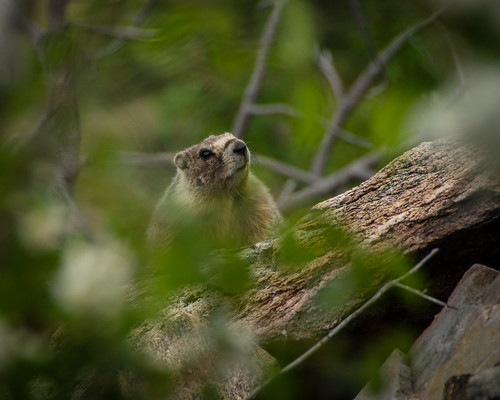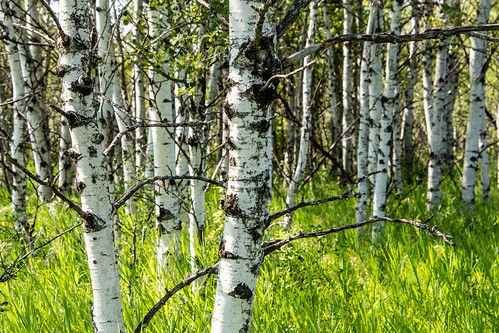“My seven-year-old loved this [Sask Parks bioblitz].She logged 41 observations and loved getting feedback from people and learning what things were. Can’t wait to do this again next year!” (EcoFriendly Sask Twitter feed)
Do you like to dig in the dirt or would you rather scan the sky for birds? Do you like solving puzzles on the computer or wonder what is happening in your backyard overnight? All these opportunities and more are available every day as the public is invited to assist scientists in collecting and processing data and working on conservation projects.
Eyes and Ears
For more than 25 years, observers have provided Plant Watch Alberta with over 55,000 records of when plants start to flower. Many of those volunteers have been involved for over 10 years providing valuable indicators of variations in the weather and the risk of early spring wildfires before the forests turn green.
In 2017, the Royal Saskatchewan Museum held one-day bioblitzes in Regina and Cypress Hills. With 665 observations of 239 different species, the Regina bioblitz provided baseline data on the species that inhabit the area. There were some exciting discoveries in Cypress Hills where volunteer plant experts identified a number of mosses and liverworts that were either new to Cypress Hills or new to Saskatchewan.
Very little is known about Calgary’s frogs, toads, and salamanders. Calgary residents enjoying a walk along the Rotary Mattamy Greenway can help by using a newly developed app, Call of the Wetland, to identify and report when they either hear or see one of these amphibians.
Citizen science projects recognize the value of local knowledge, which can supplement and guide scientific research. The LEO network in Alaska “is a network of local observers and topic experts who share knowledge about unusual animal, environment, and weather events.”
Practical Applications
Many citizen science projects have a practical purpose. Residents living near Heathrow Airport in London, England, installed devices in their homes and gardens to record noise and its impact on people and wildlife. The data was shared with local authorities and fed into the consultation process for a third runway.
Over 4500 wildlife observations in BC’s Crowsnest Pass are being used to build support for a wildlife corridor and will assist in planning a future highway expansion. A project tracking wildlife crossings and collisions along the Nova Scotia-New Brunswick border hopes to reduce the number of animals killed on the roads in that area.
Biologists, agencies, and communities involved in Grupo Tortuguero not only collected data on local turtle populations but also assisted in establishing marine protected areas and sustainable fishing practices.
Remote Control
You don’t need to be physically present to help collect data. A University of Wisconsin biologist who tracks deer, bears, and other large animals distributed thousands of motion-sensitive cameras to teachers, students, landowners, and nature-lovers. "By working with citizen scientists who put out these cameras on their own private property, we're now able to characterize areas that we wouldn't otherwise be able to go into," he says.
Soundscapes to Landscapes is mapping bird diversity in Sonoma County, California. Volunteers distribute and collect sound recorders around the area. Experts then train computers to identify the different songs, whistles, and squeaks that have been recorded.
You can be a citizen scientist from the comfort of your own home. Calgary Captured is looking for volunteers to identify the animals in photos taken by motion-activated cameras in 12 city parks. Zooniverse labels itself as people-powered research and hosts a wide variety of projects – count cells in modern and fossil leaves, classify galaxies according to their shape, or transcribe natural history museum data to make it more accessible.
Muscles
Sometimes eyes and ears aren’t enough. Conservation organizations need your muscles. You can plant sagebrush to provide nesting cover and winter forage for greater-sage grouse at Grasslands National Park or work with scientists from Calgary Zoo on the Canadian Prairie Dog Ecosystem Research Project. Volunteers with the Native Plant Society of Saskatchewan dig out invasive flowering rush, while conservation volunteers with the Nature Conservancy of Canada help tear down or repair fences, install bird boxes, and clean up shoreline debris. Volunteer gardeners are gathering every Thursday morning to whip the Native Plant Garden at Regina’s Royal Saskatchewan Museum back into shape.
Personal Benefits
Volunteering your time to help with a science project can generate huge personal benefits. Meghan Mickelson participated in a bioblitz at Nature Conservancy of Canada’s Dundurn property earlier this year. She says, “There is magic in discovering a new area: you never know what is around each bend or behind each grove of trees. . . . I love exploring, taking photos of flowers, bugs and the land.”
Tony Iwane started contributing photographs to iNaturalist when he retired. He says, “There is no question that iNat has changed the way I interact with the natural world. I find that now instead of just assessing whether something is ‘pretty’ or not, I’m much more inclined to stop and watch. I have much more respect for the natural world…There is nothing scientific about what I do, I just have a love of nature which iNat has flamed into an obsession! I now get triple enjoyment from the things I see, firstly the sighting, then working through the photos, and finally, sharing the observation with people who are interested. I value the identifications, the information available, and the fact that in some small way I may be helping.”



